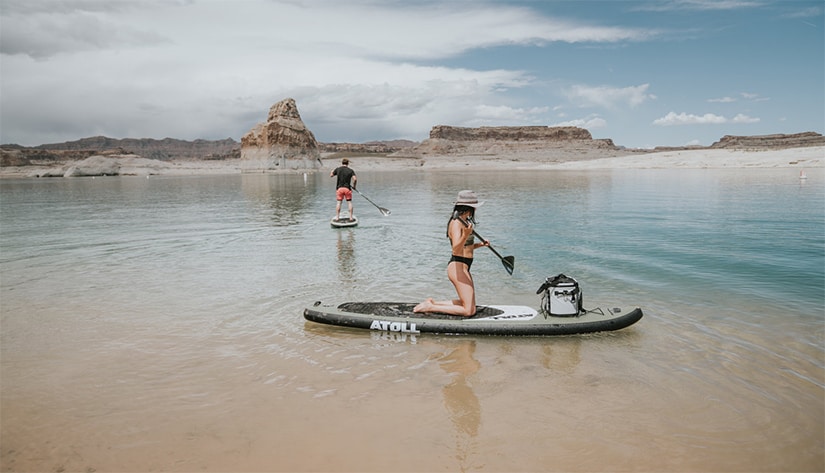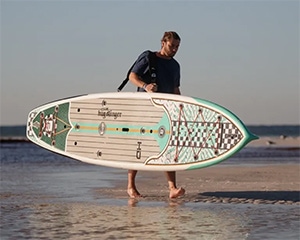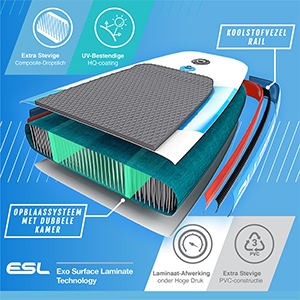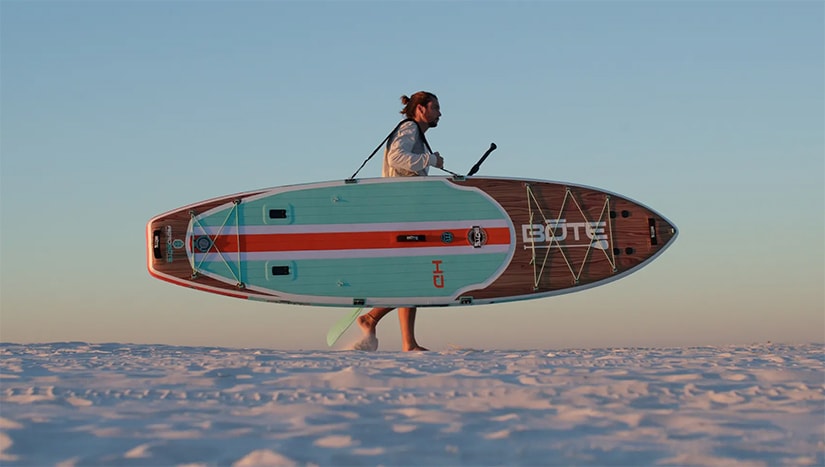A quick look at paddle board prices will leave you wondering about the price differences. How is it that some SUPs cost less than $200 while others go for $3000?
It’s a huge difference, considering that most boards look the same and come with the same accessories.
Should you go for the cheaper option or dig deeper into your pockets and get a fancier board?
To help you answer this question, we are going to look at the difference between cheap and expensive paddle boards.
RELATED: Discover the 11 Best Affordable Paddle Boards of 2024.
Key Takeaways
- The main difference between budget SUPs and high-end ones is the quality.
- Expensive inflatable boards usually have two or more layers of high-quality PVC. They are much more rigid and durable than cheaper ones. High-end solid boards are made of wood and carbon fiber.
- Another difference between cheap and expensive paddle boards is their intended use. All-around SUPs are cheaper than specific-use paddle boards.
- Inexpensive paddle board packages include lower-quality accessories–paddle, SUP bag, leash, and pump–compared to what you get with more expensive boards.
- Generally, solid paddle boards are more expensive than inflatable paddle boards.
1. Construction Technology and Materials
The main difference between budget SUPs and high-end ones is the quality. Manufacturers have to make a profit. If they use expensive materials they’ll charge a higher price for the board.
a. Solid Paddle Boards Construction
Fiberglass, carbon fiber, plastic, and wood are some of the materials used to make traditional hard boards.
The cheapest SUPs are plastic and soft-top boards.
Plastic is an affordable and easily accessible material and plastic paddle boards are equally cheap. While these boards are inexpensive and durable, they’re quite heavy and don’t perform well on the water.
More expensive SUP boards are made using wood, fiberglass, and carbon fiber. These materials are costly and stiff. Besides, the SUPs consist of layers of other materials and the construction process is not simple. The resulting paddle boards are expensive and provide exceptional performance.
Most people love wood stand up boards because of their beautiful authentic appearance. Some manufacturers will even give you the option of choosing a customized design.
b. Inflatable Paddle Boards
The construction of every inflatable paddle board begins with dropstitch material and then a military-grade PVC layer. The quality of these materials, the number of PVC layers, and the technology used are all factors that contribute to the price difference.
Cheap inflatable SUPs only have one PVC layer. Although they’re lightweight and easy to carry, their rigidity is not impressive and, as you can imagine, they aren’t durable.
Expensive iSUPs usually have two or more layers of high-quality PVC. They are much more rigid and even feel like solid boards once fully inflated. These mid-range and high-end inflatables can hold a lot of weight without flexing.
Multiple layers of PVC improve the durability of the paddle board, but can also make boards a little too heavy. As a result, some manufacturers use construction technology that allows them to make tough yet lightweight paddle boards.
2. Use: Specialized or All-Around?
Another major difference between cheap and expensive paddle boards is their intended use.
Stand up paddle boarding has grown over the years and people keep finding new ways to enjoy the sport. We now have SUP racing, yoga, touring, fishing, whitewater paddling, all-around paddling, and so much more.
The kind of paddle board that is perfect for fishing wouldn’t perform well in SUP racing. So manufacturers make SUP boards with different shapes for each activity.
Racing paddle boards, for instance, are long and narrow with a pointy nose. Most of them are traditional hard boards with a displacement hull that cuts through the water effortlessly.
Fishing paddle boards are usually super wide with many gear mounts, while others have a recessed deck for added stability.
All these special features contribute to the high cost.
Cheap SUP boards are mainly all-around paddle boards. They can be used for most SUP activities but they are not exceptional at any one of them.
3. Quality of Accessories in the Package
Most stand up paddle boards come with paddling accessories in the package. iSUPs include a backpack, leash, manual pump, paddle, fins, and maybe a repair kit. Epoxy paddle boards can come with a paddle and a leash.
Inexpensive paddle board packages include low-quality accessories, which is expected. You will normally get a simple SUP bag, a single-chamber hand pump, and an aluminum paddle. Aluminum paddles are the cheapest as well as the heaviest. They are not fun, especially when paddling long distances.
Mid-range packages are better, and you’ll probably get a fiberglass paddle which is lighter and easier to handle.
High-end SUP packages include a carbon paddle—the lightest and most efficient paddle type. On its own, a carbon paddle is quite expensive and some of them go for about $250, the price of a complete cheap SUP bundle.
The bags in this price range are heavy-duty and comfortable while the hand pumps are dual-chamber and easy to use.
4. Paddle Board Features
If you put a cheap and expensive paddle board side by side, you will notice a difference immediately.
Budget SUP boards have a pretty basic deck with a simple traction pad, a D-ring for your leash, and a bungee cord for storage. They are best suited for beginners or leisure paddlers.
Expensive paddle boards often include features that enhance comfort and convenience. These SUPs have larger grippier deck pads as well as lots of D-rings and gear mounts for attaching gear. You can attach a kayak seat, fishing rod holders, cup holders, speakers, and anything else to make your experience much more fun.
5. Inflatable Vs Solid Paddle Boards
The cheapest SUP boards on the market are inflatable, while most of the high-end ones are solid boards.
Low-end iSUP prices range from $200 to $500 while cheap traditional boards range from $600 to about $800.
The construction of inflatable paddle boards is simpler and uses cheaper materials compared to that of solid SUPs. If you want quality on a budget (plus all the basic paddling accessories), you’ll be better off with an iSUP.
6. Check the Warranty
Warranty periods are a clear indicator of quality and investment value. Premium brands like iRocker’s Blackfin models come with up to a 3-year warranty, reflecting their superior durability and performance.
On the other hand, the more affordable Nautical series offers a 1-year warranty, suitable for budget-conscious enthusiasts. Other brands follow suit, with ISLE providing a 2-year warranty, BOTE covering repairs or replacements, and Atoll iSUPs all come with a 2 year manufacture warranty against all defects.
This variance in warranty terms highlights the balance between price and quality in the paddle board market.
How Much Should You Spend on an Inflatable Paddle Board?
What’s the difference between cheap and expensive paddle boards?
Aside from the obvious price differences – it all comes down to quality. Some of the factors that affect the price of a SUP include construction, shape and intended use, accessories in the package, features, and the type of paddle board (whether it’s inflatable or a solid board).
Cheap SUPs usually have a low weight capacity and perform poorly. You should only consider a board under $400 if you’re on the smaller side or for your kids.
Cheap paddle boards include equally cheap paddling accessories.
If you’re heavier or want a paddle board for serious paddling, consider spending a little more for better quality.
Mid-range boards, around $600 – 850, offer a balance of quality and features for recreational paddlers, providing good stability, durability, and performance.
If you’re about to purchase your first paddle board, I advise you to look in this price range.
High-end models, above $1000, are designed for serious enthusiasts, offering superior materials, construction, and advanced features for optimal performance.
SUPs built using expensive materials are more expensive because quality comes at a cost. You should also expect to pay more for special-use boards and those that come with high-quality accessories.
Remember that you get what you pay for, more often than not.
Happy paddling!
Frequently Asked Questions
How does the material of a paddle board affect its price?
The material of a paddle board plays a significant role in determining its price. Cheap paddle boards are typically made from one layer of PVC.
On the other hand, expensive paddle boards are often constructed using multiple layers of PVC. This makes these boards more rigid and increases their durability.
More layers of PVC means higher material costs, increasing the price of these boards.
Are there specific brands known for producing high-quality but affordable paddle boards?
Absolutely! When it comes to high-quality yet affordable paddle boards, there are a few brands that stand out. One such brand is iRocker. Their Nautical paddle boards are durable and reliable SUPs at an affordable price point.
Another notable brand is Gili Sports. Their Air boards are very similar to the Nautical boards, but offer more color options.
These brands have successfully found the perfect balance between quality and affordability, making them popular choices among paddling enthusiasts worldwide.




